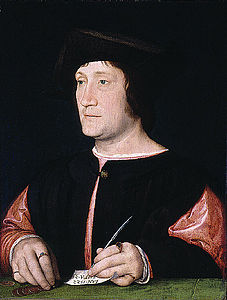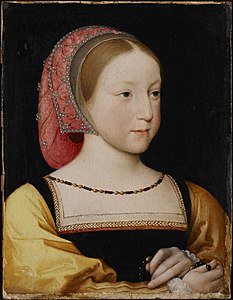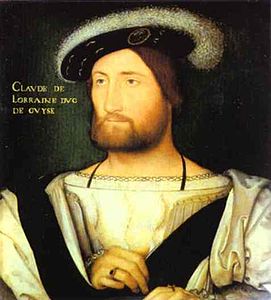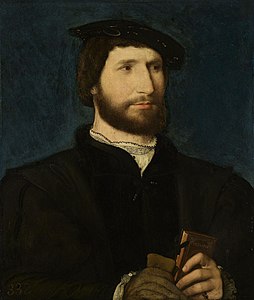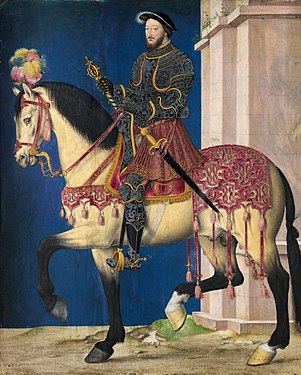Jean Clouet
Jean "Janet" Clouet | |
|---|---|
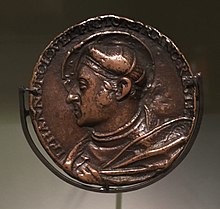 | |
| Born | 1480 |
| Died | 1541 |
| Known for | miniaturist; oil painter |
| Movement | French Renaissance |
| Patron(s) | Francis I of France |
Jean (or Janet) Clouet (1480–1541) was a miniaturist and painter who worked in France during the High Renaissance. He was the father of François Clouet.
Biography
[edit]
The authentic presence of this artist at the French court is first mentioned in 1516, the second year of the reign of Francis I. By a deed of gift made by the king to the artist's son of his father's estate, which had escheated to the crown, we learn that he was not actually a Frenchman, and never naturalized. He is supposed to have been a native of the Low Countries, and his real name was probably Cloet. He lived several years in Tours, and there it was he met his wife, Jeanne Boucault,[1] who was the daughter of a jeweller.[2]
He is recorded as living in Tours in 1522, and there is a reference to his wife's residence in the same town in 1523. In that year Clouet was awarded the position of Groom of the Chamber by the King, with a stipend at first of 180 livres and later of 240. He and his wife were certainly living in Paris in 1529, probably in the neighborhood of the parish of Ste Innocente, in the cemetery of which they were buried. He stood godfather at a christening on 8 July 1540, but was no longer living in December 1541.[2]
His brother, known as Clouet de Navarre, was in the service of Marguerite d'Angoulême, sister of Francis I, and is referred to in a letter written by Marguerite about 1529. Jean Clouet had two children, François and Catherine, who married Abel Foulon,[3] and left one son, who continued the profession of François Clouet after his decease.[2]

Jean Clouet was undoubtedly a very skillful portrait painter, although no work in existence has been proved to be his, but some few have been attributed convincingly. He painted a portrait of the mathematician Oronce Finé in 1530, when Fine was thirty-six years old, but the portrait is now known only by a print. Janet is generally believed, however, to have been responsible for a very large number of the wonderful 130 portrait drawings now preserved at Musée Condé in Chantilly, and others at the Bibliothèque Nationale. About ten paintings of him subsist and fewer miniatures, like two portrait of Francis I and two smaller ones by his workshop in the Louvre, that of un unknown man at Hampton Court, that of the Dauphin Francis, son of Francis I at Antwerp.[2]
Paintings
[edit]- Portrait of Francis I as Saint John the Baptist, 1518, oil on panel, 96.5 x 79 cm, Louvre, Paris.[4]
- Portrait of a Banker, 1522, oil on panel, 42.5 x 32.7 cm, Saint Louis Art Museum.
- Portrait of Madeleine de France, c. 1522, oil on panel, 16.1 x 12.7 cm.
- Portrait of Charlotte de France, c. 1522, oil on panel, 17.78 x 13.34 cm, Minneapolis Institute of Art.[5]
- Portrait of the Dauphin Francis of France, 1522–1525, 16 x 13 cm, Royal Museum of Fine Arts Antwerp.
- Portrait of Madame de Canaples, c. 1525, oil on panel, 36 x 28.5 cm, National Gallery of Scotland, Edinburgh.
- Portrait of Claude de Lorraine Duke of Guise, 1528–1530, oil on panel, 29 x 26 cm, Palazzo Pitti, Florence.
- Portrait of Marguerite d'Angoulême, c. 1530, oil on panel, 59.8 x 51.4 cm, Walker Art Gallery, Liverpool.
- Portrait of Francis I, c. 1530, oil on panel, 96 x 74 cm, Louvre.
- Portrait of a Man Holding a Volume of Petrarch, formerly said Portrait of Claude d'Urfé, c. 1530–1535, oil on panel, 38.4 x 33 cm, Royal Collection, Hampton Court.
- Portrait of Guillaume Budé, c. 1536, oil on panel, 39.7 x 34.3 cm, Metropolitan Museum of Art, New York.
- Paintings
-
Portrait of Francis I as Saint John the Baptist, 1518, Louvre.
-
Portrait of a Banker, 1522, Saint Louis Art Museum.
-
Portrait of Charlotte de France, c. 1522, Minneapolis Institute of Art.
-
Portrait of a Man Holding a Volume of Petrarch, c. 1530–1535, Royal Collection, Hampton Court.
-
Portrait of Guillaume Budé, c. 1536, Metropolitan Museum of Art.
Drawings and miniatures
[edit]Seven miniature portraits in the Manuscript of the Gallic War in the Bibliothèque Nationale (13,429) are attributed to Janet with very strong probability, and to these may be added an eighth in the collection of J. Pierpont Morgan, and representing Charles I de Cossé, Maréchal de Brissac, identical in its characteristics with the seven already known. There are other miniatures in the collection of Mr Morgan, which may be attributed to Jean Clouet with some strong degree of probability, inasmuch as they closely resemble the portrait drawings at Chantilly and in Paris which are taken to be his work.[2]
The collection of drawings preserved in France, and attributed to this artist and his school, comprises portraits of all the important persons of the time of Francis I. In one album of drawings the portraits are annotated by the king himself, and his merry reflections, stinging taunts or biting satires, add very largely to a proper understanding of the life of his time and court. Definite evidence, however, is still lacking to establish the attribution of the best of these drawings and of certain oil paintings to Jean Clouet.[2]
- Drawings
-
Equestrian portrait of Francis I, c. 1540, miniature on vellum, 27 x 22 cm, Louvre.
Notes
[edit]- ^ Catherine Grodecki, Documents du Mintier Central des Notaires de Paris: Histoire de l'Art au XVIe Siécle, 2 (Paris, 1986), p. 162 no. 734.
- ^ a b c d e f Williamson 1911.
- ^ Catherine Grodecki, Documents du Mintier Central des Notaires de Paris: Histoire de l'Art au XVIe Siécle, 2 (Paris, 1986), p. 162 no. 736.
- ^ Mathieu Deldicque, "Le portrait au temps des Valois, Naissance d'un art", in Grande Galerie – Le Journal du Louvre, Sept/Oct/Nov 2017, No. 41, mentionning a possible participation of Polet brother of Jean.
- ^ Portrait of Charlotte de France, c. 1522, Minneapolis Institute of Art.
References
[edit]- This article incorporates text from a publication now in the public domain: Williamson, George Charles (1911). "Clouet, Jean". In Chisholm, Hugh (ed.). Encyclopædia Britannica. Vol. 6 (11th ed.). Cambridge University Press. p. 560.
- Campbell, Gordon, ed. (2009). "Clouet [Cloet; Clauet; Clouwet; Clavet; Janet]". The Grove Encyclopedia of Northern Renaissance Art (Online ed.). Oxford University Press. ISBN 9780195334678.
- Cécile Scailliérez Francis I by Clouet, meeting des Musées Nationaux, 1996
- Dictionary Bénézit critic and documentary dictionary of painters, sculptors, designers and writers of all times and all countries, vol. 3 January 1999, p 13440. (ISBN 2700030133), p. 725
- Oxford Dictionary edited by Robert Maillard, Universal Dictionary of painting, vol. 2 Smeets Offset BV Weert (Netherlands), October 1975, p 3000. (ISBN 2850360023), p. 42-43
- (en) Peter Mellen, Jean Clouet, complete edition of the drawings, miniatures and paintings, London, New York, Phaidon Press, 1971, 262 p. (ISBN 0714814318)
- Peter Mellen (trans. Anne Roullet), Jean Clouet, Catalogue raisonné of the drawings, miniatures and paintings, Paris, Flammarion, 1971, p. 250
- Lawrence Gowing (Pref. Michel Laclotte) The paintings in the Louvre, Paris Editions Nathan, 1988, 686 p. (ISBN 2092847392), p. 204
External links
[edit]- Francis I Archived 2012-05-08 at the Wayback Machine Monumentality and miniature at Jean Clouet


